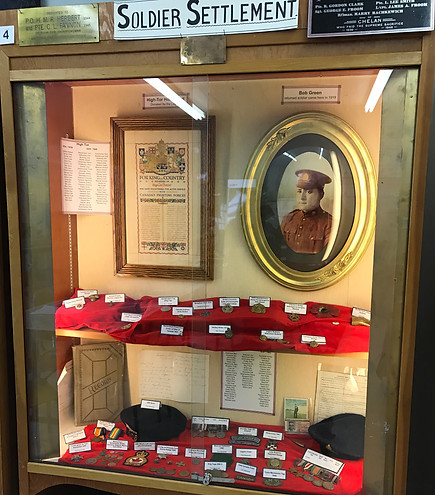
Histories of Porcupine and Area
Click on the Icon you wish to learn more about
Museum Main Exhibits/Attractions



Soldier Settlement
The Porcupine Plain Soldier Settlement is located in North-Eastern Saskatchewan. The area includes the communities of Porcupine Plain, Weekes, Carragana, and Somme.
In 1918, the Canadian Government allotted approximately 200,000 acres of land exclusively for Canadian ex-service men to encourage them to settle in the area. According to the Report of the Soldier Settlement of Canada, the Porcupine Settlement was described as " of a good quality, covered with heavy timber now held as forest reserve. The land in the Porcupine Reserve is of good quality, light chocolate loam covered fairly thickly with a medium light poplar, 2 to 3 years' growth, and willow." (Patenaude, 1921)
The first veterans to be granted land were Roy Busteed and Bob Green in 1919.

Blacksmith Shop
A blacksmith is a person who creates objects or tools using steel or iron. They can create a plethora of things, like horseshoes, gates, weapons, utensils and etc. Blacksmithing first began in the Iron Age, when man started forging various objects from iron. Blacksmiths were often very important members of society, doing many different tasks in their area. The museum pays tribute to these important craftsmen with our Blacksmith Exhibit. It hold various different tools for blacksmithing, and also various objects forged by Blacksmiths.



Trapping Shack
Trapping is a major part of Canada's heritage. Before Europeans came to the continent, it was a very important part of First Nation's way of life. Trapping provided food, shelter, and clothing for the First Nation's people. The North American fur trade began in the 1500's, and is a large part of Canada's history. From it arose companies like the Hudson Bay Company, and the North West Company, and ultimately it led the colonizing of this country. Beaver pelts were what was primarily trapped, because at the time they were used to make felt hats, which were very in fashion. Trapping opened the country to exploration and settlement, and established economic and social relationships between the European and First Nation's people.
The Parlor
A parlor is an elegentally decorated room used primarily for entertaining guests. Many 19th century houses had a parlor, which were often considered a symbol of status. They often displayed delicate china, paintings and the best furniture. The museum's "parlor' displays antique china cabinets, along with a plethora of various types of china. The walls are adorned with photos, paintings and other furnishings. Some of the china is over 150 years old, and several of the paintings that were purchased in 1930, and then later donated to the museum.



The Bird Display
The Bird Display housed in the basement of the museum shows an impressive arrangement of taxidermied birds found the area. All the birds shown are found in a 15 mile radius of Somme, Saskatchewan. Many of these birds are over 50 years old, having been taxidermied years before being brought to the museum.




Tools
The Porcupine Plain District Museum is has a large collection of tools and objects used by people in the area. The collection ranges from vehicle parts to wrenches. Some of the tools are made of various metals, and others are made from wood. For example, we have a set of "flails" on display that were used to thresh grain.

The Medical Display
When it was built in 1947, the building in which the museum resides in was originally the Porcupine-Carragana Hospital. This building was a great asset for the town until the new hospital was built later. Today, the museum still pays a tribute to the hospital through its large medical display. Here we have some of the original machines, and objects that used to be used in the hospital. We also have a a large display of pharmaceutical products that were used years ago.

The Lace Display
The bobbins display in the museum were made in between 1850-1900. Some are made of bone, others are made of wood. The wooden ones are intricately decorated with shaped rings, metal inlays, or wire bindings. The beads on the bobbins were used as weights to make weaving easier and to prevent tangling. The girls who owned the bobbins were very proud of them, and young men would often decorate bobbins with their girlfriend's name, or loving words to give as gifts.
The lace in the display was made by hand between 1875-1900. It was made on a hard pillow following a pattern of holes on cardboard. Some people say that Barbara Utfman invented this method of lace making in the 1500's.


Citations/Consults
Harris, Herbert R. Book of Memories and a History of the Porcupine Soldier Settlement, Province of Saskatchewan, Canada, 1919-1967. Saskatchewan: Shand Agricultural Society, 1967. Print.
Porcupine Plain And District Historical Society. Cordwood Days to Modern Ways: Carragana, Chelan, High Tor, Porcupine Plain, Somme, Weekes. Porcupine Plain, Saskatchewan: Porcupine Plain & District Historical Society, 1978. Print.
Pautenaude, J. O. "Report of the Soldier Settlement of Canada .. : Canada. Soldier Settlement Dept : Free Download & Streaming." Internet Archive. Canada Soldier Settlement Board, n.d. Web. 12 Apr. 2017..

